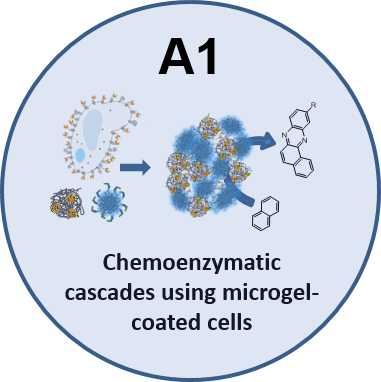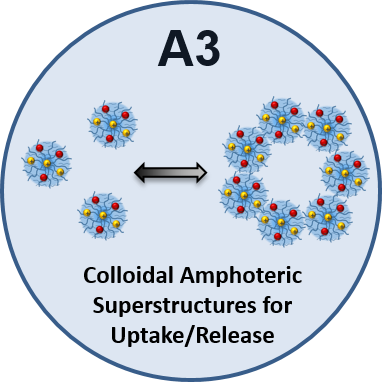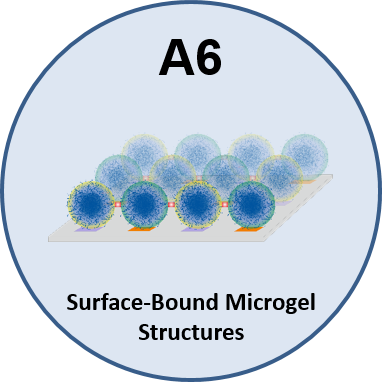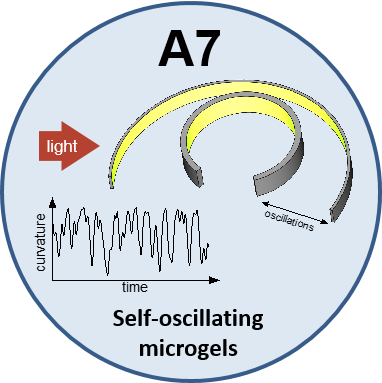Project Area A
Functional microgel assemblies
Research area A focuses in the 3rd funding period on the use of the functional stimuli-responsive microgels with complex chemical structures and morphologies developed in the past as building blocks for the fabrication of microgel assemblies and for catalysis, actuation and controlled motion. In the new funding period, projects in research area A will use self-assembly of microgels in solution, in emulsions, at solid surfaces and on cell surfaces to fabricate complex microgel-based materials. Apart from the fundamental investigations focusing on the behavior of microgels in concentrated/crowded systems and properties of microgel-based assemblies, we will explore the application of microgel assemblies in pH-triggered actuation, light-driven oscillation/motion as well as in cell-mediated (bio)catalysis.
Project A1 will use microgels with integrated bio- and chemo-catalysts (enzymes or metal complexes) assembled and strongly attached by non-covalent interactions to the surface of whole cells using anchor peptides to perform catalytic reactions. The yeast cells will display on their surface fungal unspecific peroxygenase enzymes (UPO). UPOs can oxidize a wide spectrum of aliphatic and aromatic compounds using hydrogen peroxide. The decoration of whole cells with soft microgels will be tuned to form a protective layer that ensures survival of enzyme in organic solvents and efficient whole cell catalysis.
Project A3 will focus on the assembly of ampholytic and temperature-responsive aqueous microgels. Ampholytic microgels will be investigated at high packing densities to understand their colloidal phase behavior, the response of individual microgels to crowding, the response to stimuli (pH, T) as well as the release of guest species. Furthermore, the assembly of ampholyte microgels in dilute solutions, in confinements (droplets or channels) and at interfaces will be studied to fabricate tailor-made stimuli-responsive supracolloidal structures with defined size and shape and to investigate their swelling-deswelling and actuation in aqueous solution.
Project A6 will address surface-bound microgels. The binding of microgels to surfaces will enable creating new microgel superstructures and investigating structural properties of microgels and the transport within them with advanced microscopic methods. Furthermore, the interaction of microgels with differently modified surfaces and the resulting deformation can be addressed. As a key element, the hybridization of DNA provides a stimuliresponsiveness in addition to, and independently of, the one of the volume phase transition of the microgels. Microgels with DNA in the inner regions will be able to bind (macro)molecules or small nanoparticles to track their diffusion inside the microgels upon thermal release. The DNA functionalization will further allow for the formation of reversible and stimuli-responsive crosslinks via DNA hybridization and, thereby, for control of the mechanical properties, i. e. the stiffness, of surface-bound 1D−3D microgel/DNA superstructures.
The goal of Project A7 is to develop a self-oscillating microgel system that is photothermally driven by continuous-wave laser light using gold nanorods incorporated into or on the microgels as optical absorbers. In the new funding period the focus will be on investigations of multi-frequency self-oscillations of thin microgel bilayer ribbons. Systematic time-resolved measurements will be carried out to analyze oscillatory motions, the optical spectra and temperatures of the photothermally heated ribbons, as well as the temperatures and convection flow rates of the surrounding water. With a view to a potential future operation of these self-oscillators as engines, attempts will be made to reduce the number of frequency components of the motion. The experimental results will be compared to theoretical multi-physics kinetics simulations that take microscopic processes in the microgels and hydrodynamic coupling to the environment into account.




